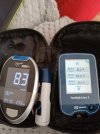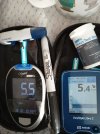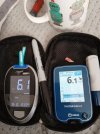Spathiphyllum
Well-Known Member
- Relationship to Diabetes
- Type 1
Proud, condolences regarding your house sale! But, returning to Pandy8's husband's problem with multiple night-time alarms:... Going low seems, from all that I've heard and read in the last 18 months, to be more damaging than going high. If that is an incorrect understanding, why are the International consensus recommendations from the 2019 ADA Conference promulgating Clinical Targets for Continuous Glucose Monitoring for Time in Range as depicted in Figure 1? Notably under 4% below 3.9 and under 25% for above 10.0?
The link you posted is only to one chart from the 2019 international consensus statement on clinical targets, not the full statement/article. Here is the full text: https://diabetesjournals.org/care/a...cal-Targets-for-Continuous-Glucose-Monitoring . Amongst other things, it says this:
"When applying the CGM metrics in clinical practice, it may be more meaningful and motivating to communicate to people with diabetes the importance of working to reduce the time spent <70 mg/dL (
So the international consensus, at least as of 2019, from dozens of experts around the world including the UK, and supported by the American and European diabetes associations, is that it's ok to dip below 3.9, provided it's for less than an hour a day. (And even below 3, provided it's for less than 15 minutes a day.) If you generally keep your glucose levels at or above 3.9 during the day, waking yourself up at night every time your levels dip even briefly below 3.9 may well mean a lot of unnecessary sleep disruption, which is itself harmful to your health.
Bottom line, though-- the problem Pandy8 describes is something her husband really must discuss with his consultant!! Obviously the best solution would be to find a way of adjusting his insulin and/or his carbohydrate consumption so that his alarms didn't keep going off overnight.
Personally-- to stop being woken up repeatedly, I didn't only (as mentioned in a previous post) lower the level at which my low-glucose alarm went off; I also started always checking my glucose level, and the way the arrows were pointing, before bed, and having a little snack if it seemed advisable.
And, looking just now at my graphs, I now see this has actually been the key thing! Since making this change, I haven't even gone below 3.9 at night; almost every night coasting in the range of 5-7.
(Although Pandy8's husband's alarm levels may need changing too, if Pandy8 is right in saying that his high alarm is set at 9.8 and his low at 4.5 ... Surely that would be bound to cause glucose ping-pong?? The only point of having the alarms is to make corrections. High alarm, inject some insulin-- with such a tight range, high risk of overcorrection-- leading to low alarm, consume some carbs-- with such a tight range, high risk of overcorrection-- rinse and repeat and end up completely wrung out the next day ...)
Anyway, Pandy8, I hope for you and your husband's sake you get this sorted out! All the best.



